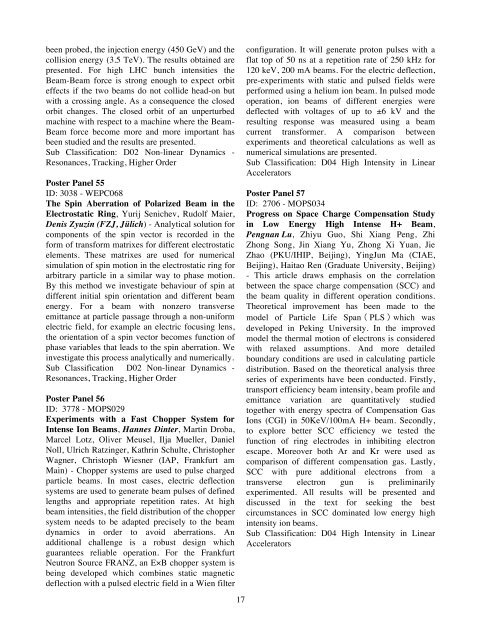Abstracts Brochure - 2nd International Particle Accelerator Conference
Abstracts Brochure - 2nd International Particle Accelerator Conference
Abstracts Brochure - 2nd International Particle Accelerator Conference
You also want an ePaper? Increase the reach of your titles
YUMPU automatically turns print PDFs into web optimized ePapers that Google loves.
een probed, the injection energy (450 GeV) and the<br />
collision energy (3.5 TeV). The results obtained are<br />
presented. For high LHC bunch intensities the<br />
Beam-Beam force is strong enough to expect orbit<br />
effects if the two beams do not collide head-on but<br />
with a crossing angle. As a consequence the closed<br />
orbit changes. The closed orbit of an unperturbed<br />
machine with respect to a machine where the Beam-<br />
Beam force become more and more important has<br />
been studied and the results are presented.<br />
Sub Classification: D02 Non-linear Dynamics -<br />
Resonances, Tracking, Higher Order<br />
Poster Panel 55<br />
ID: 3038 - WEPC068<br />
The Spin Aberration of Polarized Beam in the<br />
Electrostatic Ring, Yurij Senichev, Rudolf Maier,<br />
Denis Zyuzin (FZJ, Jülich) - Analytical solution for<br />
components of the spin vector is recorded in the<br />
form of transform matrixes for different electrostatic<br />
elements. These matrixes are used for numerical<br />
simulation of spin motion in the electrostatic ring for<br />
arbitrary particle in a similar way to phase motion.<br />
By this method we investigate behaviour of spin at<br />
different initial spin orientation and different beam<br />
energy. For a beam with nonzero transverse<br />
emittance at particle passage through a non-uniform<br />
electric field, for example an electric focusing lens,<br />
the orientation of a spin vector becomes function of<br />
phase variables that leads to the spin aberration. We<br />
investigate this process analytically and numerically.<br />
Sub Classification D02 Non-linear Dynamics -<br />
Resonances, Tracking, Higher Order<br />
Poster Panel 56<br />
ID: 3778 - MOPS029<br />
Experiments with a Fast Chopper System for<br />
Intense Ion Beams, Hannes Dinter, Martin Droba,<br />
Marcel Lotz, Oliver Meusel, Ilja Mueller, Daniel<br />
Noll, Ulrich Ratzinger, Kathrin Schulte, Christopher<br />
Wagner, Christoph Wiesner (IAP, Frankfurt am<br />
Main) - Chopper systems are used to pulse charged<br />
particle beams. In most cases, electric deflection<br />
systems are used to generate beam pulses of defined<br />
lengths and appropriate repetition rates. At high<br />
beam intensities, the field distribution of the chopper<br />
system needs to be adapted precisely to the beam<br />
dynamics in order to avoid aberrations. An<br />
additional challenge is a robust design which<br />
guarantees reliable operation. For the Frankfurt<br />
Neutron Source FRANZ, an E×B chopper system is<br />
being developed which combines static magnetic<br />
deflection with a pulsed electric field in a Wien filter<br />
�<br />
17<br />
configuration. It will generate proton pulses with a<br />
flat top of 50 ns at a repetition rate of 250 kHz for<br />
120 keV, 200 mA beams. For the electric deflection,<br />
pre-experiments with static and pulsed fields were<br />
performed using a helium ion beam. In pulsed mode<br />
operation, ion beams of different energies were<br />
deflected with voltages of up to ±6 kV and the<br />
resulting response was measured using a beam<br />
current transformer. A comparison between<br />
experiments and theoretical calculations as well as<br />
numerical simulations are presented.<br />
Sub Classification: D04 High Intensity in Linear<br />
<strong>Accelerator</strong>s<br />
Poster Panel 57<br />
ID: 2706 - MOPS034<br />
Progress on Space Charge Compensation Study<br />
in Low Energy High Intense H+ Beam,<br />
Pengnan Lu, Zhiyu Guo, Shi Xiang Peng, Zhi<br />
Zhong Song, Jin Xiang Yu, Zhong Xi Yuan, Jie<br />
Zhao (PKU/IHIP, Beijing), YingJun Ma (CIAE,<br />
Beijing), Haitao Ren (Graduate University, Beijing)<br />
- This article draws emphasis on the correlation<br />
between the space charge compensation (SCC) and<br />
the beam quality in different operation conditions.<br />
Theoretical improvement has been made to the<br />
model of <strong>Particle</strong> Life Span � PLS � which was<br />
developed in Peking University. In the improved<br />
model the thermal motion of electrons is considered<br />
with relaxed assumptions. And more detailed<br />
boundary conditions are used in calculating particle<br />
distribution. Based on the theoretical analysis three<br />
series of experiments have been conducted. Firstly,<br />
transport efficiency beam intensity, beam profile and<br />
emittance variation are quantitatively studied<br />
together with energy spectra of Compensation Gas<br />
Ions (CGI) in 50KeV/100mA H+ beam. Secondly,<br />
to explore better SCC efficiency we tested the<br />
function of ring electrodes in inhibiting electron<br />
escape. Moreover both Ar and Kr were used as<br />
comparison of different compensation gas. Lastly,<br />
SCC with pure additional electrons from a<br />
transverse electron gun is preliminarily<br />
experimented. All results will be presented and<br />
discussed in the text for seeking the best<br />
circumstances in SCC dominated low energy high<br />
intensity ion beams.<br />
Sub Classification: D04 High Intensity in Linear<br />
<strong>Accelerator</strong>s


